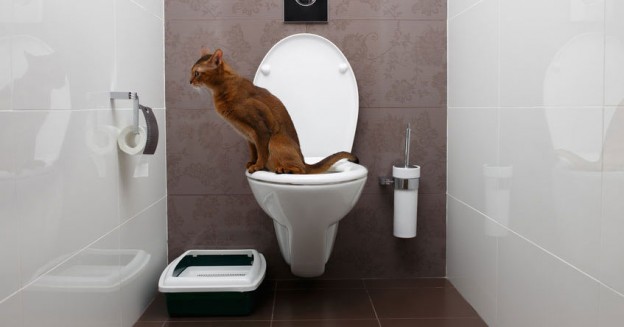The Risks of Flushing Cat Poop in Your Toilet - Preventive Steps
The Risks of Flushing Cat Poop in Your Toilet - Preventive Steps
Blog Article
Just about everyone will have their unique theory when it comes to How to Dispose of Cat Poop and Litter Without Plastic Bags.

Introduction
As pet cat owners, it's vital to be mindful of just how we throw away our feline good friends' waste. While it may seem hassle-free to purge pet cat poop down the bathroom, this practice can have destructive effects for both the atmosphere and human health.
Ecological Impact
Purging cat poop presents dangerous microorganisms and parasites into the water system, positioning a significant threat to water ecosystems. These impurities can negatively impact aquatic life and compromise water top quality.
Health and wellness Risks
In addition to ecological issues, purging feline waste can also present health threats to humans. Pet cat feces may contain Toxoplasma gondii, a bloodsucker that can create toxoplasmosis-- a potentially serious ailment, particularly for expecting females and individuals with weakened body immune systems.
Alternatives to Flushing
Luckily, there are safer and a lot more responsible methods to dispose of feline poop. Take into consideration the complying with choices:
1. Scoop and Dispose in Trash
The most typical approach of taking care of feline poop is to scoop it right into a biodegradable bag and throw it in the garbage. Be sure to utilize a committed litter scoop and take care of the waste quickly.
2. Usage Biodegradable Litter
Choose naturally degradable pet cat litter made from materials such as corn or wheat. These clutters are eco-friendly and can be safely thrown away in the garbage.
3. Bury in the Yard
If you have a yard, think about hiding cat waste in an assigned location far from veggie gardens and water sources. Make sure to dig deep sufficient to stop contamination of groundwater.
4. Mount a Pet Waste Disposal System
Invest in an animal garbage disposal system especially created for pet cat waste. These systems make use of enzymes to break down the waste, minimizing smell and environmental impact.
Verdict
Liable pet possession extends past providing food and shelter-- it also includes proper waste management. By refraining from purging feline poop down the commode and opting for different disposal techniques, we can minimize our ecological impact and safeguard human health.
Why Can’t I Flush Cat Poop?
It Spreads a Parasite
Cats are frequently infected with a parasite called toxoplasma gondii. The parasite causes an infection called toxoplasmosis. It is usually harmless to cats. The parasite only uses cat poop as a host for its eggs. Otherwise, the cat’s immune system usually keeps the infection at low enough levels to maintain its own health. But it does not stop the develop of eggs. These eggs are tiny and surprisingly tough. They may survive for a year before they begin to grow. But that’s the problem.
Our wastewater system is not designed to deal with toxoplasmosis eggs. Instead, most eggs will flush from your toilet into sewers and wastewater management plants. After the sewage is treated for many other harmful things in it, it is typically released into local rivers, lakes, or oceans. Here, the toxoplasmosis eggs can find new hosts, including starfish, crabs, otters, and many other wildlife. For many, this is a significant risk to their health. Toxoplasmosis can also end up infecting water sources that are important for agriculture, which means our deer, pigs, and sheep can get infected too.
Is There Risk to Humans?
There can be a risk to human life from flushing cat poop down the toilet. If you do so, the parasites from your cat’s poop can end up in shellfish, game animals, or livestock. If this meat is then served raw or undercooked, the people who eat it can get sick.
In fact, according to the CDC, 40 million people in the United States are infected with toxoplasma gondii. They get it from exposure to infected seafood, or from some kind of cat poop contamination, like drinking from a stream that is contaminated or touching anything that has come into contact with cat poop. That includes just cleaning a cat litter box.
Most people who get infected with these parasites will not develop any symptoms. However, for pregnant women or for those with compromised immune systems, the parasite can cause severe health problems.
How to Handle Cat Poop
The best way to handle cat poop is actually to clean the box more often. The eggs that the parasite sheds will not become active until one to five days after the cat poops. That means that if you clean daily, you’re much less likely to come into direct contact with infectious eggs.
That said, always dispose of cat poop in the garbage and not down the toilet. Wash your hands before and after you clean the litter box, and bring the bag of poop right outside to your garbage bins.
https://trenchlesssolutionsusa.com/why-cant-i-flush-cat-poop/

Hopefully you enjoyed our excerpt on Can You Flush Cat Poo or Litter Down the Toilet?. Thanks a lot for spending some time to read our blog post. Enjoyed our review? Please share it. Help someone else check it out. Thank-you for going through it.
Get An Estimate Report this page